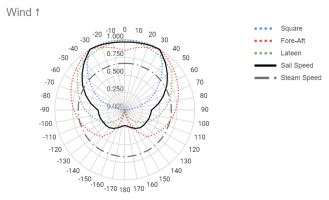Difference between revisions of "Wind"
m (Added Category) |
Zachgaudio (talk | contribs) m (Edited out Taipan due to it having same speed as Cutlass/Stiletto now, clarified trivia) Tag: visualeditor |
||
| Line 18: | Line 18: | ||
[[File:Wind Diagram.png|alt=Wind Diagram|left|thumb|329x329px|A diagram showing how different sail types are affected by wind]] | [[File:Wind Diagram.png|alt=Wind Diagram|left|thumb|329x329px|A diagram showing how different sail types are affected by wind]] | ||
[[File:Retaliator Tilt.png|alt=Retaliator Tilting|none|thumb|670x670px|A Retaliator with full wind tilt towards port side versus a Retaliator with full wind tilt towards starboard side]] | [[File:Retaliator Tilt.png|alt=Retaliator Tilting|none|thumb|670x670px|A Retaliator with full wind tilt towards port side versus a Retaliator with full wind tilt towards starboard side]] | ||
| − | |||
| − | |||
| − | |||
Revision as of 05:29, 20 April 2022
Wind is a game mechanic that directly affects the speed at which ships travel according to their direction respective to the wind. The wind pattern in Tradelands is that of circle around a rock in the center of the map between Fenwick and Perth, often referred to as "Wind Rock". The wind changes directions between clockwise and counter-clockwise every 3 real life days. The direction of the wind relative to your ship can be determined using the direction in which the ship's flag is pointed. Sailing with the wind is referred to as sailing "downwind", against the wind as "upwind", and perpendicular to it as "crosswind".
Sail Types
In Tradelands, ships can have one or a combination of three types of sails: square sails, lateen sails, and fore-aft sails. Each sail performs differently according to the direction of the wind relative to your ship. Square sails are superior to other sails when sailing downwind, however are significantly worse when sailing crosswind than other sail types. Fore-aft sails, though not as swift as square sails downwind, can go much faster crosswind than the other sails. Lateen sails represent a mixed performance, being superior to square sails but inferior to fore-aft sails at sailing crosswind and superior to fore-aft sails but inferior to square sails when sailing downwind.
Steam Engines
Certain ships, such as the Dragon and Fox, are equipped with steam engines that enable them to travel in any direction, with or against the wind at a constant speed. Steam engines are activated by pressing the E key. When a steam engine is activated, the engine speed overrides the sail speed of the ship, making this power best used when traveling crosswind or upwind. Running an engine consumes Coal at a rate relative to the power the engine is running at, at a rate of 1 coal per 45 seconds at full throttle and slower as the speed of the ship is slowed. This rate is not affected by the maximum engine speed of the ship.
Ship Tilt
Ships have a natural rocking motion at all times. This motion is exaggerated in the direction in which the wind is blowing relative to the ship. This phenomenon is generally referred to as "wind tilt", with the degree of tilt being dependent on the ship being used, as well as if the sails of the ship are raised or dropped. The angle of the ship relative to the wind does not affect the amount of wind tilt a ship achieves, only whether it is blowing to port or starboard side. This mechanic is often utilized by experienced helmers to gain a range advantage over the opponent, allowing the ship to fire at a distance at which the opposing ship is unable to return fire. In addition, the starboard side of a ship will rock further downwards than the port side, a phenomenon often referred to as "port side tilt". Experienced helmers may also use this mechanic to gain a range advantage over an opposing ship, even if both ships have their ships tilting in favorable directions, or to counter an opponent's advantage in wind tilt by increasing the range at which fire can be returned.
Trivia
- Due to the different performance between sails, certain ships may be faster than other ships in certain directions even if the Shipwright indicates it has a lower speed, for instance, the Stiletto and Cutlass, which are listed as having a speed of 10, will travel faster downwind than a Dart, which has a speed of 11, due to their square sails being faster than the Dart's fore-aft sails downwind.
- Wind in the Burkeland tile travels in the same pattern as the Grand Isles, despite its lack of a "wind rock". The southeastern island can instead be used as a reference point.
- The wind in the Burkeland and Eastern Sea tiles will always travel the opposite direction of the current wind direction in the Grand Isles.

